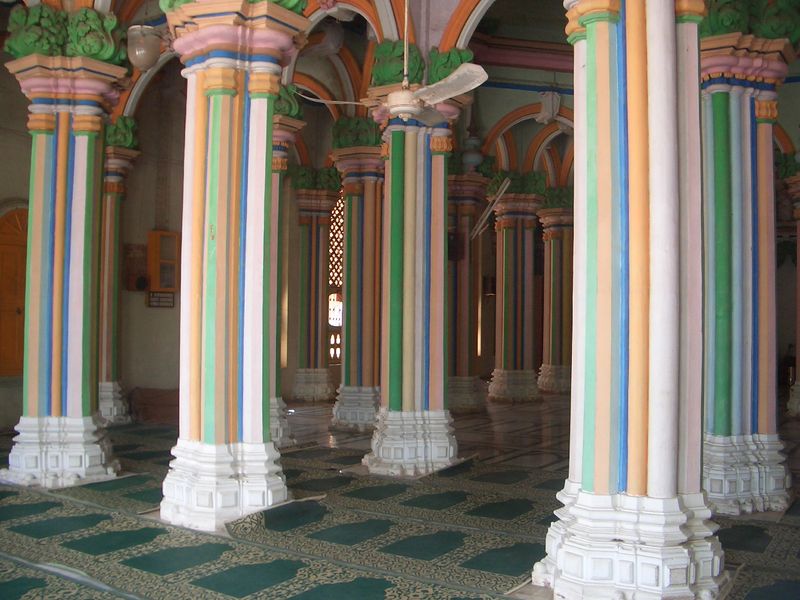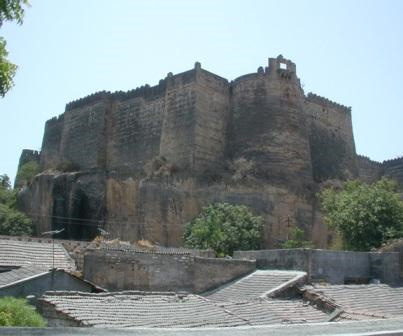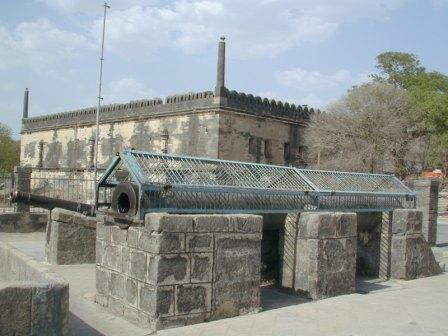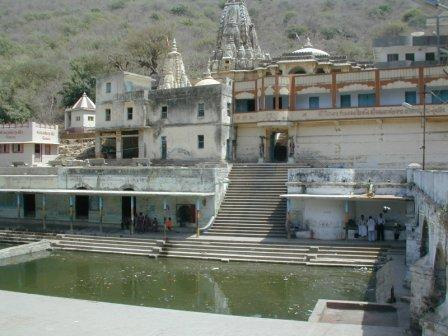How to reach here:
By Air: The nearest airport is at Keshod, which is around 40 km from Junagad. It is a domestic airport and its connectivity is limited. The nearest international airport is at Ahmedabad and the airport is well connected to the major parts of the country and abroad.
By Rail: The city of Junagadh has a major railway station, and this station is well connected through rail to the cities of Ahmedabad (Somnath Express), Veraval (Jbp Somnath Exp) and Rajkot (Vrl Bct Pass Ex).
Best time to visit: October to March
Languages spoken: Gujarati, Hindi.
Must eat: Thepla, Khatta-Mittha Bhaat,Fansi ma Dhokli nu Shaak, Ganthoda nu Shaak,Lilva Kachori,Keri no ras.
Famous Restaurants: Garden Restaurant, Santoor.
Places you must visit:
Moti Baug is a garden stretched across an area of 2,485 hectares, which includes the 754.62 hectares of land that is the campus of the Agricultural University of Junagadh and Botanical Garden. The entire land includes 17 sub centers, which are manned by 1,500 people.

The Science Museum at Junagadh is the first and sole science museum privately owned in Gujarat. There are over 60 science projects in this museum, which are related to science facts and can be managed by visitors. There is also a small aquarium and an open-air garden restaurant which serves Punjabi and South Indian dishes in the evening.

Darbar Hall Museum originally belonged to the Nawab of Junagadh. Historical artifacts of that time can be seen in this hall that is segmented into sections like palanquins, arms gallery, picture gallery, textile gallery and the Kacheri. Visitors can also see various thrones, weapons, howdahs, costumes, armors tapestries and chandeliers, silver articles, gowns, cushions and carpets and several other things. The carpet is famous especially because it was woven in jail.


Jami Masjid is known for its 140 pillars that support the ceiling of this mausoleum. The pillars were brought from Chudasana Palace. Located on the Mahatma Gandhi Road, these decorated Maqbaras were built in the 19th century for the Muslim rulers.Of all the tombs, the most magnificent is the one belonging to Mahabat Khan I that was constructed in 1892. This mausoleum has silver minarets, doors and staircases in winding patterns.



In the middle of the town of Junagadh, there is the ancient Upper Fort or Uparkot on the plateau, which is believed to have been built around 312 BC by Changradupta Maurya. This fort has a long history that includes 16 attempts to besiege this fort over a period of 800 years.One of these sieges, lasted for 12 years but was unsuccessful. This fort after its construction remained in oblivion for 300 years and was rediscovered during 976 AD. It was finally deserted around the 7th or 8th century after which it was hidden by the neighboring jungles.The gateway of this fort has a triple entrance style, which takes visitors to the remnants of a huge cannon, 15-feet high, known as ‘Nilamtope’ that was built in Egypt in 1531. The Nawab of Junagdh obtained the ‘Nilamtope’ from a Turkish Sultan.There are two step wells in this fort popularly known as ‘Navghan Kuva’ and the ‘Adi Chadi Vav’. The Navghan Kuva was built in the 11th century and is 50 metres deep, which can be navigated by a flight of stairs in the circular pattern inside the well. On the other hand, the bottom of the Adi Chadi Vav can be reached by a set of 170 circular steps.






Ashok Shilalekh or the rock edicts of Emperor Ashoka. One particular rock edict of Ashoka can be found in an area between Junagadh and Girnar Hill. On walking 3 km from Girnar Hill or 2 km eastward from Junagadh, this rock with inscriptions that date back to 250 BC can be seen. The instructions penned on this rock are related to dharma, peace, morality, harmony and tolerance.The rock is basically uneven in shape, with a circumference of seven meters and height of 10 metres. On the rock, the 14 inscriptions of Emperor Ashoka are written with an iron pen, in the Brahmi script of the Pali language.Although the edicts mostly direct people to follow the beliefs of Buddhism, there are also some inscriptions carved in Sanskrit. These Sanskrit writings were added later on by the rulers, which describes a continuous flood in this region that resulted in the destruction of the embankments of the presently non-existent Sudershan Lake.


Swami Vivekananda Vinay Mandir is one of the oldest secondary and higher secondary schools in Gujarat. It stands on a large land with gardens, playground and old domes. This school is mostly famous for two students, Jainil Dewani and Dhirubhai Ambani.

Sakkarbag Zoo is India’s third oldest zoo and the oldest zoo of Gujarat. It is known to breed Gir lions and supply it to other zoos. Inside the complex of this zoo, there is a museum that exhibits rare collection of stuffed animals, art furniture, Persian Sanskrit inscriptions, ancient coins and other artifacts.There are three sections of the zoo, the Wild Animals Section, Deer/Antelope Section and Birds Section. Inside the zoo, visitors can see animals like leopards, monkeys, wolves, bears, snakes, crocodiles, fish, etc. The zoo, which is a part of a garden, also has an extension named Safari.


The Junagadh Museum exhibits unique collections of ancient coins, manuscripts, art furniture, archaeological items, stuffed animals, statues, Persian Sanskrit inscriptions, and etc. People can also see the remnants of Harappan culture that were discovered in Intali, preserved here.


Damodar Kund is located at the base of the Girnar Mountain. This kund is considered the place, where during a cruise, the garment of Goddess Parvati and Lord Shiva fell.This water pond or kund is believed to have been built in 500 AD, by Lord Krishna’s great-grand son Vajranabha. This is a check dam, which is reconstructed frequently.There is another Kund called Revati Kund that is near to the Damodar Kund. A story associated with this kund says that after the marriage of Revati to Lord Balarama, her father Revata left Dwarka and shifted close to the Girnar Hill.In the north of Damodar Kund, close to the Aswatthama Hill, the Damodarji Temple is situated, which is also believed to have been constructed by Vajranabha.


Junagadh Caves:
Khapra Kodia Cave: On the basis of scribbles and short cursive letters on the wall, Khapra Kodia caves are datable to 3rd-4th century AD. This is the plainest of all cave groups. The chambers are cut into an east-west longitudinal ridge. The important components of the caves are the oblong western wing and the 'L' shaped wing used by Monks as a monsoon shelter.

Baba Pyara Caves:The Group of caves lying close to the Modhimath is known as Baba Pyara. The northern group of it has four caves. The next set of caves lies little to the south of the eastern end of the first group and has a unified plan with a spacious court and a chaitya hall, apsidal in shape. The cave pillars and door jambs of the caves suggest a clear impact of art traditions of Satavahanas period and are datable to 1st-2nd century AD on the basis of architecture.

Satguru Rohidass Ashram : It is believed that Satguru Ravidass ji has spent approximately 15 years of his life at Sarsai Village of District Junagadh of Gujarat and become famous with name Satguru Rohidass Ji.It is a great place of worship for Satguru Rohidass followers. A very old temple of Satguru Ravidass (Rohidass) Ji is also here in this Ashram. In front of this temple a Yagya Hawan Kund is also present; which has an historic value. According to the old folks of Sarsai; few decades ago, there were 7 Kunds (Pool) related with Satguru Ravidass Ji. But, now only 3 Kunds are left.One Kund is named as Shram Kund; where Satguru Ravidass ji was doing his work of Leather. Second Kund is named as Shaan Kund, which is related with story of Pandit Ganga Ram and Ganga. It is believed that King Kankan of that place became very fascinated and highly impressed by the spiritual power of Satguru Ravidass Ji; hence they became his Followers. Third Kund named as Hemano Kund where the followers of Satguru Ravidass ji are doing “Pind Daan”. All these Kunds were created by Satguru Ravidass (Rohidass) Ji to fight against man made discrimination based on caste, color or creed.Satguru Ravidass Ji taught the lessons of universal brotherhood, tolerance, message of love your neighbor, which has got more importance in today's world.



No comments:
Post a Comment